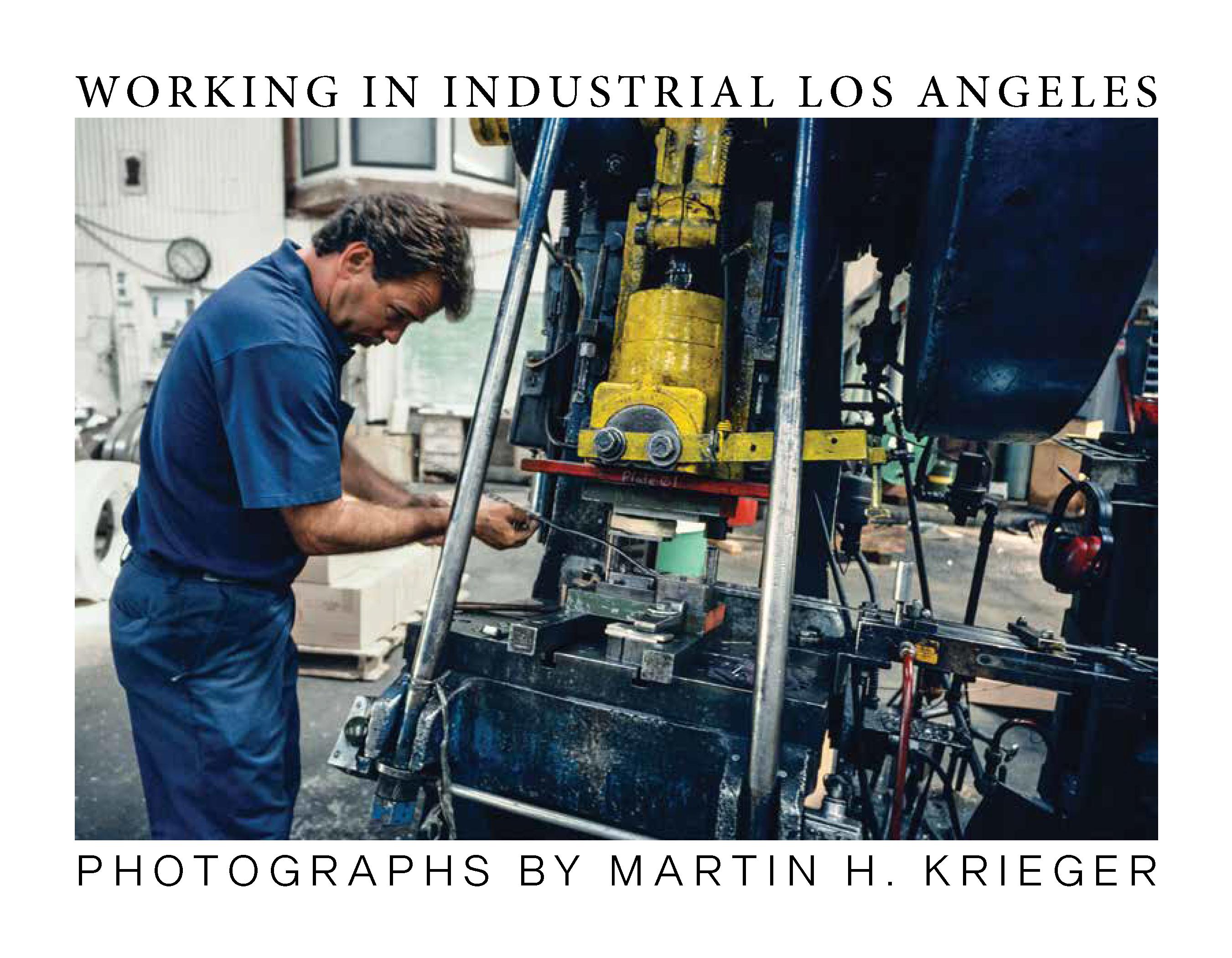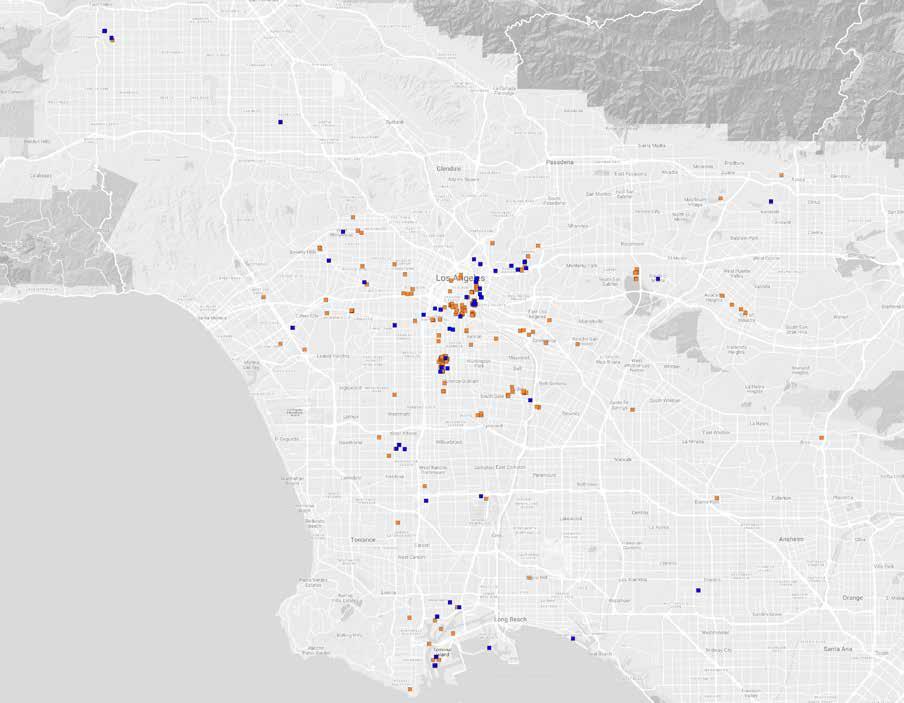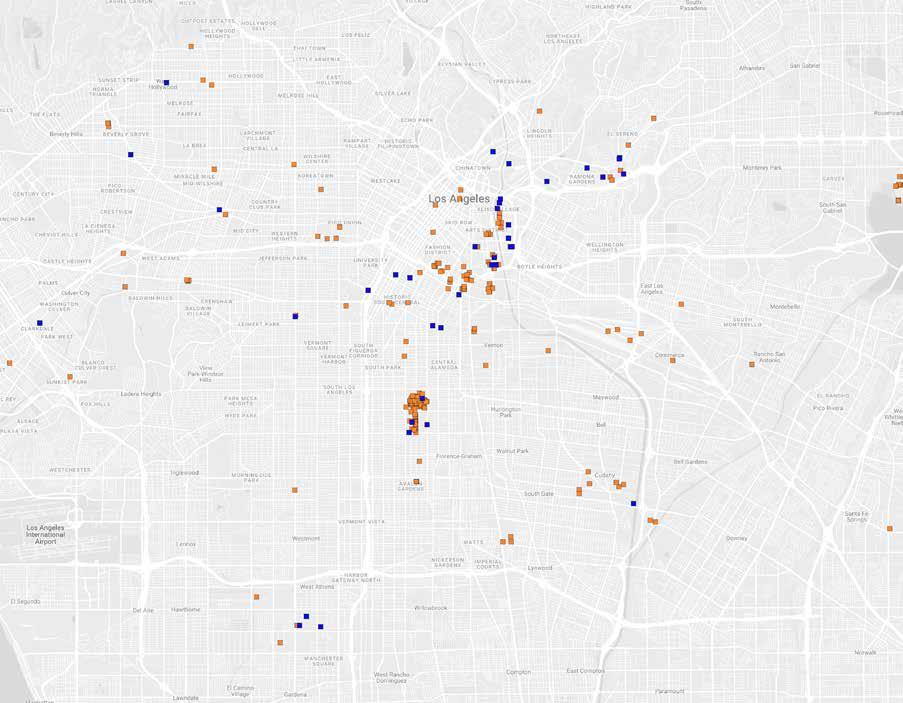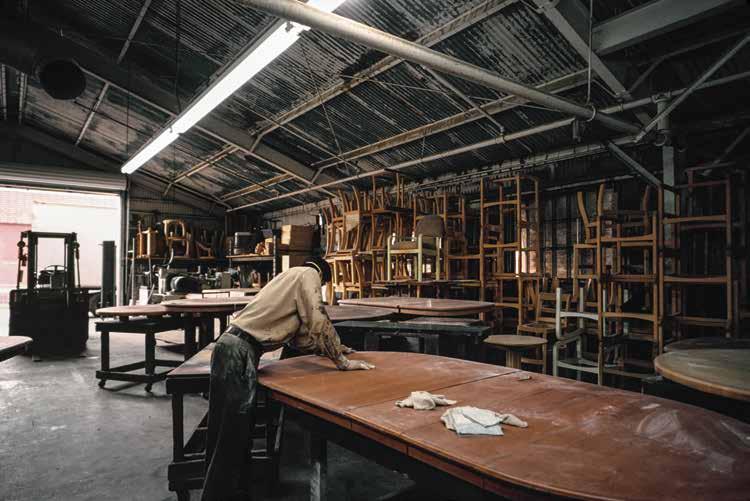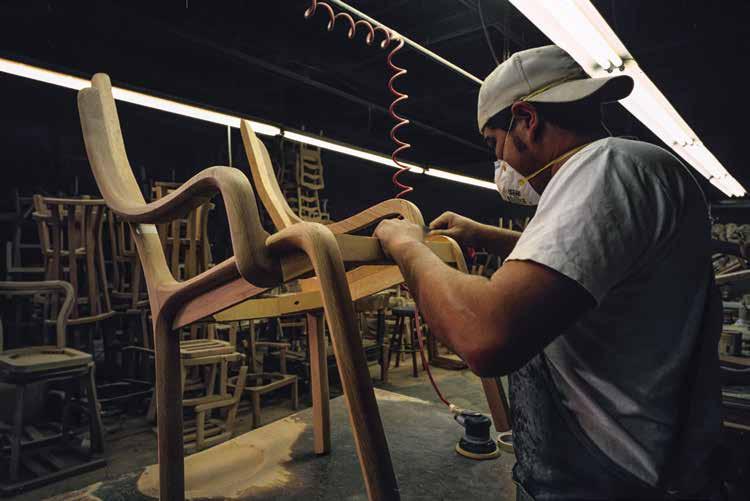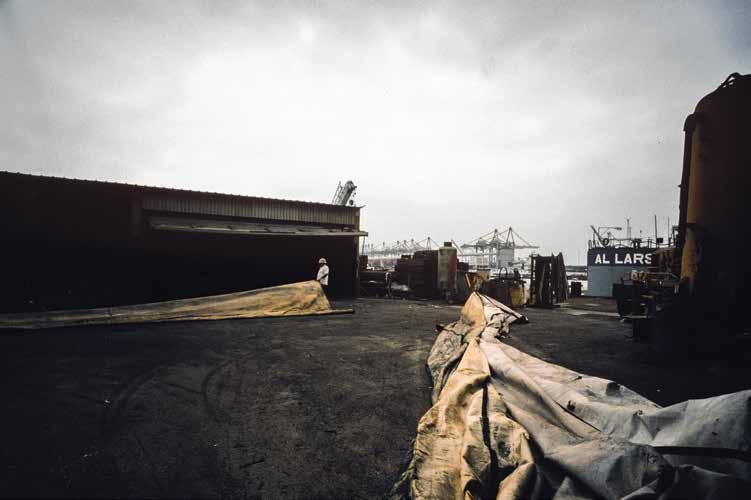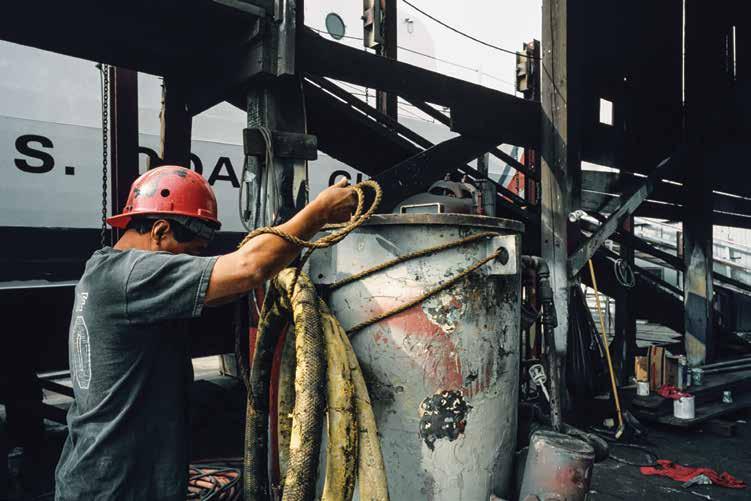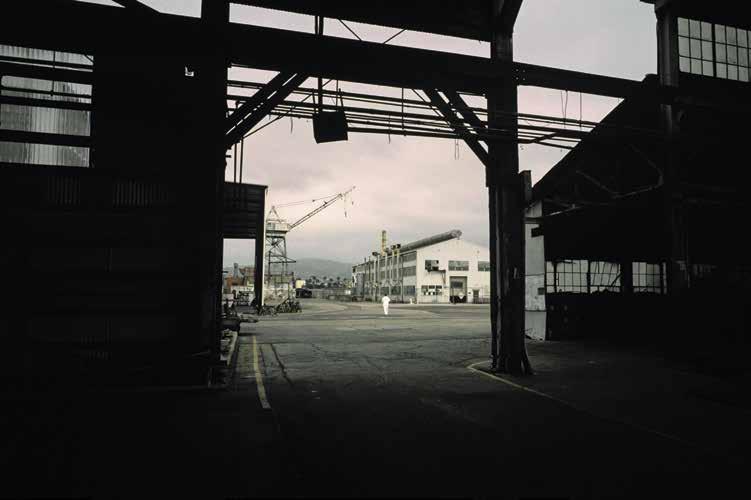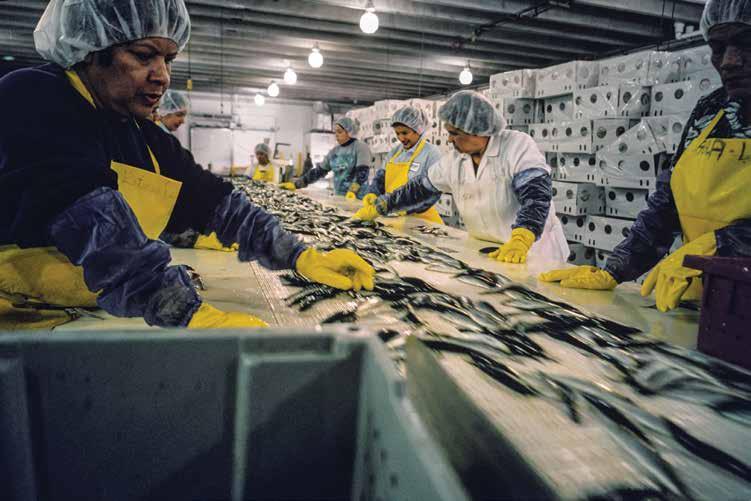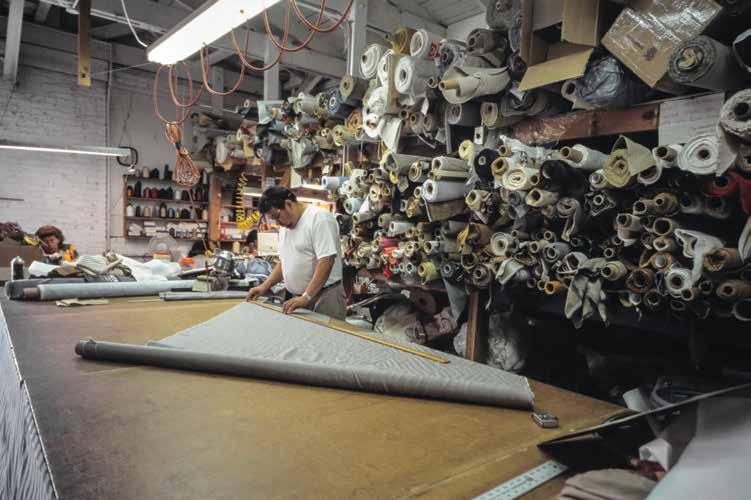CONTENTS
PREFACE
– Martin H. Krieger
“NATURE’S WORKSHOP”
– Greg Hise
MAP OF SITES VISITED
IMAGES
LOCATIONS
“NATURE’S WORKSHOP”: ACKNOWLEDGMENTS AND NOTES
THE AUTHORS
vii xv xxxii 1 111 113 116
PREFACE
I am a voyeur.
When I am walking or driving in Los Angeles, where I teach, I keep asking, What’s going on here, in this place at this site? Being a professor of city planning, my curiosity seems appropriate, although most academic studies depend on archives, interviews, statistical information, and remote sensing. When I notice a high frequency of the same phenomenon, say storefront houses of worship, eventually my awareness is awakened and I wonder, What’s going on here, and why? Initially, I do not go out and look for these phenomena. But their insistence and ubiquity kick me in the pants.
Almost nothing is without a history and sociology, worked out by my colleagues in the universities. And for administrative reasons, corporations and governments gather information that may put my curiosity in context. I am not the first to be interested in what is going on around himself, and monetizing these phenomena (say, taxes or sales) is a powerful motivator.
The phenomena are ubiquitous and frequent, although most of the time we are trained to ignore what is in front of our noses–we have work to do. I find that whatever it is I am discovering, let us call it an “identity,” is presented to me in manifold examples or profiles. Each such profile is distinctive, but shared features impress upon me that I am seeing something rather more general, that “identity.” After years of driving to work on
the same street, it finally occurred to me that there were many storefront churches on the way. And sure enough, those churches were often Pentecostal. Early in the twentieth century, Los Angeles was a source for the revival of such experiential religiosity.
There was a time when Los Angeles was taken to be quite far from the centers of manufacturing, and the costs of transport (even by rail) encouraged local production of automobiles and tires. Eventually, that distance was conquered by interstate highways and trucking, and so there was less need for the Ford Model A plant near downtown Los Angeles, or the General Motors plant in the San Fernando Valley, or the Goodyear tire manufacturing facility just south of the Huntington tract I discuss below. Such infrastructure came to be used for warehousing, mass-retailing in shopping centers, and for smaller manufacturing enterprises. The small stores around trolley stops, frequented by transit commuters on the way to and from work, were less viable as the automobile became dominant, and so those stores located at the intersections of main streets and trolley lines were available at lower rents for other uses, such as a small house of worship.
Los Angeles is the major industrial center in the United States. For the past decades, Greg Hise has been writing historically on the relationship of industry to housing and urban development in Los Angeles. In the first decade of this century, I photographically documented major Los Angeles institutions, including its storefront houses of worship, its electrical distributing system, and its industrial streetscapes. All of this work has been
VII
intimately informed by historical and social-science understanding of cities, Los Angeles, and industrialization.
Comparatively little is known or documented about Los Angeles’ industrial enterprise and its structure. There are the better-known documentary traditions in cities like New York, Chicago, Paris, and London. But few cities have invoked the power of images as insistently as Los Angeles. That relationship may be illustrated most readily by reference to place promotion and the creation of a regional identity through the marketing of Southern California’s climate, landscape, and agricultural abundance. But what sold the region in the 1880s (richly detailed portraits of fruit and vegetables) was quite different from Chamber of Commerce advertising in the 1920s (oblique aerials of manufacturing and production) or more recent promotions of social and cultural diversity and architecture (both high-style and low-brow). Photography and processes of city building have developed in a reciprocal manner over time.
I began to photograph industrial Los Angeles when I encountered the Union Pacific Avenue industrial complex (located in the area of East Los Angeles bounded by the 101 and the 710 freeways) while photographing some storefront houses of worship that I had tracked down. (I had been photographing the facades of hundreds of storefront churches in Los Angeles.) It was hard to miss the grain elevators. I mentioned my discovery to my historian colleague Professor Greg Hise, who then showed me his recent article on industrial Los Angeles. I was launched.
I then received a small grant from the John Randolph Haynes and Dora Haynes Foundation to photograph industrial streetscapes. Every once in a while, I would shoot a few photographs of the insides of these firms through an open bay, or if I happened to be invited in. People were curious about what I was doing in their neighborhood. I discovered that if I asked to photograph inside small- to medium-sized firms, I would get a “Yes” perhaps one-third to one-fifth of the time. We then received a more substantial grant from Haynes to do intensive photographing of industrial Los Angeles factories, warehouses, and other such sites. I have photographed at perhaps 225+ such sites.
In addition, with the guidance of Professor Dominick Miretti, a long-time member of Local 63 (Marine Clerks) of the fabled International Longshoremen’s and Warehousemen’s Union (ILWU), I photographed extensively at the Ports of Los Angeles and Long Beach. Also, I flew six helicopter trips (with traffic reporter Chuck Street) to see the lay of the industrial land and how it was intermixed with all sorts of other uses. And with the support of its administration, I photographed people at work (avoiding patients, as HIPPA rules required), at the iconic Los Angeles County-USC Hospital just before a transition to a new hospital building nearby. Many a regular television medical drama would begin with an image of that massive building.
My focus was people at work, at their worksites, and also when they were on breaks or on the way to work. Using Reference USA and Dun’s Million Dollar service, I was able to get further information on most of
VIII
the firms I photographed, but not all.
I spent a lot of time in an industrial area south of Slauson and north of Florence, between Central and Avalon, readily recognized from the air. Almost surely, it was
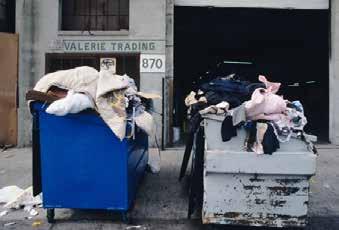
developed by Huntington interests in the 1920s. More generally, it is straightforward to discover industrial districts from the satellite imagery supplied by Google. The extensive grey roofs are the sign. It may be useful to give a concrete example of the fieldwork (Friday, September 12, 2003, 8:30-10:30am). I had been trying to photograph the actual production processes of industrial Los Angeles, and not only the streetscape. I decided to drive down Central Avenue to that Huntington tract industrial district. I had already systematically photographed all the buildings and streets in this district. And I had earlier photographed a furniture factory and a plastics molding factory.
The manager of a used-clothing sorting enterprise welcomed me in. Charities collect clothing, they take the best clothes for their thrift shops, and sell the rest (98%), by the 1,000-pound bale, to these enterprises. Clothing is then sorted, different customers get different quality and kinds of clothing: white T-shirts become wiping cloths for paint stores; Japanese college students go through specific piles of clothing for specific sorts of garments, according to faxes they received from Japan the previous evening. The proverbial T-shirt ends up in Central America or Africa, although Central and South America usually demand higher quality clothing. The best used clothing comes from places with too few thrift shops and the right sort of givers, so this company’s used clothing comes from Detroit and Grand Rapids charities. The business is a low margin enterprise (say, buying at 2c a pound and selling at 3c). All the usual issues of the

IX
minimum wage, workers compensation, etc., come to the fore.
I photographed the worksite where sorting, folding, and packing take place. I also recorded the acoustic ambience of this place and of the surrounding areas. What is valuable here and what is distinctive is its concreteness and specificity, the flesh and mortar, so to speak.
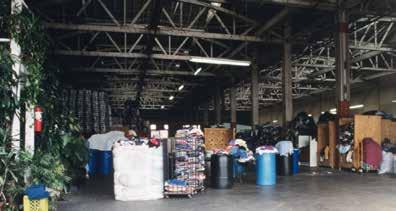
Much of what we call visual documentation is often of those less powerful, less well off, less protected by status and bureaucracy. In looking over my archive, I realize that almost all the work pictured requires no more than a secondary education and perhaps trade school. In part, these were the places I had access to. They were not corporate bureaucracies. Working-class people, a fraction of whom actually made good wages, were at the mercy of the minimum, filling jobs that they had filled for much of the time since the beginning of the twentieth century. They are working for a living. Their children and grandchildren might go to college and not follow in their footsteps. I’m not sure who will do the same sort of work in twenty-five years.
To colleagues, I say that I have been doing social-science-informed photographic documentation of Los Angeles. By “social-science-informed” I mean that I have
tried to be systematic and I have chosen my subjects for their implications for the larger structure of the City as understood in the scholarly literature. Storefront houses of worship (650+), Los Angeles City Department of Water and Power electrical distribution stations and related sites (150), and the industrial streetscapes (maybe 125+ blocks and streets, perhaps 5,000+ images) are such topics, and my photographing has been all over the City and to some extent the County as well. Along the way I have in addition extensively photographed at the Ports of Los Angeles and Long Beach, the Los Angeles County Hospital just as it was about to close, and made five short videos of particular firms. And I made six helicopter trips to see the lay of the industrial land (intermixed with all sorts of other uses).
There have been similar efforts over the years, whether they be documentary photography of social conditions, the Mass Observation movement in Britain in the 1930s and ‘40s, or the work of Mark Klett in landscape documentation.
My reflections on this work are in my book, Urban Tomographies (2011). In writing about what I called the vernacular sacred, those storefront houses of worship, I discussed such informal religiosity, Pentecos-
X
talism, and the intimate connection with Los Angeles’ history. The work on the industrial streetscape connects with an account of the urban economy as a diversified, mixed specialty and export economy, with niche markets, networks of factories supplying each other, and a highly adaptable industrial sector (what is sometimes called “flexible specialization”). These conceptions have been drawn from Hise’s historical work and the social-science literature.
My goal has been to produce photographs that are of high quality, in their detail and definition, and in the choice of perspective and composition. Good technique leads to photographs that are information dense–especially if those photographs are part of a systematically produced and organized corpus. I have not aimed to produce photographs that would be conventionally thought to be fine-art photographs. (However, I have learned much from fine art photographers [ for example, Lee Friedlander ] and from photojournalists, about ways one might do this sort of documentation.) I have tried to avoid irony and celebration. I want to show what’s there, what’s ordinary, what is repeated again and again, ubiquitously, in its variety and particularity. And what you see (or hear) is deeply rooted in larger societal and economic processes. I want to make the city visible and hearable to those who live in it.
I should note that Charles Marville, photographing Paris’s transformation (or evisceration) under Baron Haussmann and Napoleon III in the mid-nineteenth century (~1870), used glass plates 10 ½ x 14 ½ inches and a tripod, and the wet plate collodion process he
employed was effectively grainless whatever its intrinsic definition–and surely the lens was not so well corrected as a modern optic. But if you have a hundred times the area of a 35mm negative, as Marville did, there is lots of room for information. In any case, when I was photographing the churches I did use the medium-format (2 ¼” square) Hasselblad–someone, sometime might want detail that I had otherwise ignored. By the way, for the Encyclopédie, a century earlier, Diderot went out and interviewed workers and observed their actual work. The engravings for the Encyclopédie are inspiring, and are available in a Dover Books reprint.
Almost all the photographs were taken with 35mm transparency film using a wide-angle 19mm lens on a Leica R8 single-lens reflex camera, or a 21mm lens on a Contax G2 rangefinder camera–mostly Kodachrome 200 shot at 500, and when that was no longer possible, Fuji Provia F400, often pushed to 800. (The outdoor streetscapes were often shot with Kodachrome 64, but the problem would then be, what if I were invited inside?) I did do some industrial photographing with a Hasselblad SWC/M, wide-angle medium-format camera, and then sometimes with color negative film.
Zeiss referred to the f/4.5 lens on the Hasselblad SWC/M as suitable for documentation, and given the medium-format of the SWC/M (5.6 x 5.6 cm.) there was a lot of information in the image. Given the impromptu nature of my visits to industrial sites, and my desire not to disturb people at work too much, the 35mm camera with a faster lens was less obtrusive and more convenient. However, given the higher speed film I needed indoors
XI
(I did not use a flash), the camera-film system was not up to “documentation.” Of course, there was lots of detail in the 35mm image (2.4 x 3.6 cm.), but nothing compared to what was achievable with a larger negative.
The transparency film is usually mounted slides (but not for the medium-format work). When I was photographing streetscapes I did not mount the images, but left them in strips so the adjacencies were apparent. (One then has to be sure that one is photographing in the right direction–the direction of the film’s motion, so that adjacent images on a strip continue each other.)
Again, my purpose in photographing is to show the world as it is, the photograph being detailed enough and of sufficient definition, that if you got curious you could enlarge the image and might discern what was written on a desk or on the wall. Again, I want to show what’s there, what’s ordinary, what is repeated, again and again, ubiquitously, in its variety and particularity. And what you see (or hear) is deeply rooted in larger societal and economic processes.
There is, however, another form of documentation provided by a photograph–that of the ambiance and experience of a place and time, and here the 35mm camera is more than adequate. The idea is to create images that engage the viewer, ask the viewer to look more closely, to imagine what it is like to be there, doing that work, working for a living in industrial Los Angeles. To get lost in an image, to allow your imagination free reign, to be free of the demands of the caption and the detail provided by the conventional scholarship, may well allow for a veridical experience vital for understanding a world that
is quite nearby, literally down the street, but practically taboo for most residents of a big city like Los Angeles. Yes, your uncle or mother might work manufacturing furniture or sewing garments, but in general most residents are in fact quite unattached to the industrial life right around them.
There is much more photodocumentation work to be done on industrial Los Angeles, exploring areas I have not documented as well as revisiting some that I have, photographing inside these industrial places, showing both the manufacturing processes and the worksites. There are particular industries that call out for further work: fashion and furniture, for example. There will be surprises, such as the “rag trade” I described earlier. There is as well the Alameda Corridor, currently of great interest to policymakers and transportation scholars. As for the choice of sites, I have aimed for a range and variety of locales throughout Los Angeles, focusing on older and smaller-sized areas, often adjacent to residential areas. (Hise has shown how important is the interaction of the residential and industrial areas.) Still, lots of territory remains unexplored.
Along the way, I photographed interesting commercial strips for selected streets, since retail is an industry. But the main reason, my motive, was when we were doing work on Boyle Heights as an ethnic neighborhood, and I noted the wonderful strips on City Terrace Drive. Subsequently, I did some inside photographs of ethnic stores, showing their wares (as displayed) and customers. This was done under the rubric of Vernacular Visual Merchandising.
XII
Aural documentation. I did some accurate and calibrated aural documentation of the sound environment of these various sites. So far, much of the work on sound documentation of urban life is allied with music or with art (performance, environmental). There is much to be learned from these endeavors (e.g., CDs of the sounds of New York buildings’ heating and air conditioning systems, or their elevators; Tokyo at “the turn of the millennium”). But, again, my imperatives and goals will be somewhat different. I think it is important to experiment with combining sound and visual documentation, less as in a museum and more in an attempt to start asking new questions about Los Angeles.
In Professor Hise’s essay on industrial Los Angeles, you will find economic and historical context, as well as social and political motives. But for me, in making these photographs, in going out and knocking on doors, saying, “I am a professor of city planning at USC and would like to photograph people at work in your factory (what I sometimes called the choreography of work) for our archive,” the greatest reward was going out and getting inside.
The archive of images produced in my fieldwork is extensive. Many of the images are available in the US C Digital Library, at calisphere.org. Some of my diverse work on Los Angeles and New York City may be found at sites.google.com/view/urban-tomographies.
I was fortunate to enlist Mr. Jonah Greenstein, a filmmaker, to select and color-correct the images. His efforts and my earlier ones were supported through grants from the John Randolph Haynes and Dora Haynes
Foundation. Professor Dominick Miretti of Local 63 of the ILWU was my guide at the Ports, Mr. Frank Toscano was my guide at the former County Hospital, Mr. Chuck Street allowed me to fly along with him in his traffic reporting work, and Professor Greg Hise guided me about industrial history and geography.
Martin H. Krieger Fall 2022
XIII
I am a voyeur.
“NATURE’S WORKSHOP”: ACKNOWLEDGMENTS AND NOTES
The author thanks Kathy Kolnick and Todd Gish for research assistance. Martin Krieger, Ted Muller, Robert Lewis, and Dick Walker offered incisive comments on drafts.
1. The undiscovered city–to all wonders of Southern California, add another: industrial Los Angeles turns out more dollar product than Pittsburgh, Fortune 39 (1949) 76–83, 148, 150, 153–54, 156, 158, 160; quotes pp. 78, 82.
2. The magnitude and nature of change in California during the war years is a topic of scholarly debate. For an introduction see R. Lotchin, World War II and urban California: city planning and the transformation hypothesis, Pacific Historical Review 62 (1993) 143–71, a critique of G. Nash, The American West Transformed: The Impact of the Second World War (Bloomington, 1985) and M. Johnson, The Second Gold Rush: Oakland and the East Bay in World War II (Berkeley, 1993). See also Lotchin, Fortress California, 1910–1961: From Warfare to Welfare (New York, 1992).
3. In “Symbolic landscapes: some idealizations of American communities,” Donald Meinig fixed southern California as the culture hearth for the third of three symbolic American landscapes: single-family housing on broad, landscaped lots sited along curved streets with direct access to freeways. Meinig overstates the importance of a landscape type that accounts for a small percentage of regional development. Meinig (ed.) The Interpretation of Ordinary Landscapes (New York, 1979) 169. For overviews of the literature see M. Marsh, Reconsidering the suburbs: an exploration of suburban historiography, Pennsylvania Magazine of History and Biography 112 (1988) 580–605; and J. Phalen, The Suburbs (New York, 1995). See also the introduction in G. Hise, Magnetic Los Angeles: Planning the Twentieth-Century Metropolis (Baltimore, 1997).
4. Hise, op cit, 82.
5. See the essays in a special issue of American Quarterly 46 (1994) and the exchange among K. Jackson, R. Fishman, and R. Harris in Journal of Urban History 13 (1987) and 15 (1988). For Los Angeles see Hise, op. cit.; R. Longstreth, From City Center to Regional Mall: Architecture, the Automobile, and Retailing in Los Angeles, 1920–1950 (Cambridge, 1997); B. Nicolaides, In search of the good life: community and politics in working-class Los Angeles (Ph.D. thesis, Columbia University, 1993) and ibid. My Blue Heaven: Life and Politics in the Working-class Suburbs of Los Angeles (Chicago, 2002); N. Quam-Wickam, “Petroleocrats and proletarians”: work, class and politics in the southern California oil industry, 1917–1935 (Ph.D. thesis, University of California, Berkeley, 1993).
6. The Chamber of Commerce used this logotype from at least 1914. See its Manufacturers Directory and Commodity Index from that year and subsequent editions. The Chamber’s industrial department adopted the slogan for books and pamphlets, see, for example, Los Angeles–Nature’s Workshop, The Home of Efficient Labor (Los
Angeles, 1921) and Dynamic Los Angeles County (Los Angeles, 1938).
7. C. McWilliams, Southern California: An Island on the Land (Salt Lake City, 1946/1990) chaps. 12, 16; R. Fogelson, The Fragmented Metropolis: Los Angeles, 1850–1930 (Cambridge, 1967) especially chap. 6; K. Starr, Material Dreams: Southern California Through the 1920s (New York, 1990); M. Davis, City of Quartz: Excavating the Future in Los Angeles (London, 1990) 118–20; R. Romo, History of a Barrio: East Los Angeles (Austin, 1983) chap. 4.
8. For an early critique of this ideology see W. Woehlke, “Smoke-stacks on the Pacific,” Sunset 31 (1931) 1161–71. For a contemporary assessment that introduces race as a central factor in labour hiring practices, see C. Johnson, Industrial Survey of the Negro Population of Los Angeles, California, Made by the Department of Research and Investigations of the National Urban League (1926). In The Productivity of Labor in the Rubber Tire Manufacturing Industry (New York, 1940), J. Gaffey asserts that labour savings were not a critical factor for establishing west coast operations and the selection of southern California for branch plants.
9. The Chamber published a running account of firms establishing plants. See the annual reports produced by the industrial department as well as 19 articles in Southern California Business such as “Bringing new industries to town” (1925) 16–17. According to the California State Mining Bureau, approximately 10,000,000 pounds of lead valued at roughly $700,000 were mined in the state during 1923, California Mineral Production for 1923 cited in W. French, A study of locational factors for industrial plants in and about Los Angeles, California (unpublished MBA thesis, University of Southern California, 1926), 95.
10. “City Industrial Tract,” Report for A. Arnoll by H. Lafler, Sales Agent, Walter H. Leimert Co, (c. 1923) in Los Angeles Area Chamber of Commerce collection, Department of Special Collections, University of Southern California, box 74 (hereafter LAACC Collection).
11. French, op. cit., chap. 4; quote p. 23.
12. Eberle & Riggleman Economic Service, “The industrial land situation in Los Angeles,” Weekly Letter (28 December 1925); idem. “Some considerations of the Los Angeles industrial situation,” Weekly Letter (21 September 1925) (no pagination). This concern was a constant. Fifteen years later, planner Bryant Hall noted a “disturbing” ratio of industrial land relative to population in the county. See the tabulations and annotations in a joint Works Progress Administration/Regional Planning Commission, Land Use Analysis (1940) part of a WPA sponsored survey of land use and population. Binder in the Regional Planning Collection, The Huntington Library, San Marino, California (hereafter The Huntington).
13. City Industrial Tract, 4.
14. M. Davis, Sunshine and the open shop: Ford and Darwin in 1920s Los Angeles, in T. Sitton and W. Deverell (eds.), Metropolis in the Making: Los Angeles in the 1920s (Berkeley, 2001).
113
15. Editorial, special section, Midwinter Edition, Los Angeles Times, January 1, 1905.
16. Los Angeles City Directory Co., (Inc.), Los Angeles City Directory, 1905.
17. See the material in the California Ephemera Collection, Department of Special Collections, UCLA, box 39, folder Industry–Historical–CA–1 (hereafter UCLA Ephemera). Quote from brochure: The Development of an Idea. WPA researchers collected these documents for The Industrial Section in Workers of the Writers’ Program of the Works Projects Administration, Los Angeles: A Guide to the City and Its Environs (New York, 1941/1951), 167. See also A. Bynon and Company, Los Angeles City and County Directory, 1886–1887 (Los Angeles, 1887), 164 and K. Doyle, A factory here since 1860, Southern California Business 10 (1931), 14; Soap company plans new five-story building, Los Angeles Times (3 September 1922) Part V, 4.
18. “The Wholesale Terminal–Efficiency For: The Wholesaler, Jobber, Shipper, Merchant, Manufacturer, Consumer,” (c. 1916); Los Angeles–A Good Place to Manufacture or Warehouse, (nd); Los Angeles Union Terminal Company, Terminal Refrigeration Company, Union Terminal Warehouse, (nd), all in UCLA Ephemera, box 39, folder Industrial–History #1. Bringing the railway and its freight customer together, Electric Railway Journal 50 (July 7, 1917), 6–7.
19. Oxnam quote in Los Angeles tenement problem, Municipal League Bulletin 3 (1925), 5.
20. French, op. cit. See also the tract maps in The Huntington Library ephemera collection, Eph J3–4(5) as well as the land use maps the WPA produced in collaboration with the Los Angeles Regional Planning Commission (Volume 6, Sheet 37) also at The Huntington.
21. CCIH, A community survey made in Los Angeles City, (San Francisco, 1919). Industrial and Business Property, Los Angeles Times (19 January 1926) Part 2, 17. In her “Aircrafters” column published in The War Worker 1 (Second half, July 1943), 2, Esther Beverly Owens noted that the Lockheed Aircraft Plant 7, located on Seventh Street “across the bridge from Santa Fe Avenue” was “thickly populated with American Negroes, Mexicans, and members of other groups” busy wiring pivot casings and drilling subassemblies. In Industrial Strength, Los Angeles Times (3 August 1997) D–1, the author tours readers through a “200-block area east of L.A.’s skyscrapers” with aging buildings, razor-wire, and homeless encampments, “fertile ground for foreign trade and immigrant entrepreneurs” engaged in the garment, printing, produce, and wholesale sectors.
22. For a discussion of pollution in turn-of-the-century Los Angeles see D. Johnson, A serpent in the garden: institutions, ideology, and class in Los Angeles politics, 1901–1911 (unpublished Ph.D. thesis, UCLA, 1996) especially chap. 3.
23. For a history of zoning in Los Angeles, and the effect of these regulations for zoning in other cities and national guidelines, see K. Kolnick, Order Before Zoning: Land Use Regulation in Los Angeles (Ph.D. thesis, University of Southern California, 2008). For a contemporary assessment of the significance of these statutes see L. Veiller, City planning in Los Angeles, The Survey 26 (22 July 1911), 599– 600. For the district boundaries see Ordinance N.17135 (new series, 1908), Ordinance N.17136
(new series, 1908), and Ordinance N.19500 (new series, 1909).
24. Industrial Lands, in the LAACC Members’ Annual (1929), 82. Agenda item in Stenographer’s Notes, 1922 (14 December 1922), 6. Both items in the LAACC Collection, box 18.
25. On labor-management, strikes, and the 1910 bombings see G. Stimson, Rise of the Labor Movement in Los Angeles (Berkeley 1955), especially chaps. 19 and 21.
26. A. G. Arnoll. Balanced Prosperity in the Los Angeles Area, a presentation sponsored by the Inter-City and Suburbanization Committee of the Los Angeles Municipal League. Printed in the Municipal League Bulletin 6 (March 1924) np. At the time, Arnoll was assistant secretary for the LAACC and director of its industrial department.
27. Torrance, The Model Industrial City, UCLA Ephemera, box 103, folder Torrance. 28. Manufacturing committee–Westinghouse track connections, in Los Angeles Area Chamber of Commerce, Stenographer’s Notes, Board of Directors Meetings, 1922, 2–5, LAACC Collection, box 18.
29. G. Law quoted in P. Sheehan, Hollywood as a World Center (Hollywood, 1924), 20–21.
30. See Fogelson, Fragmented Metropolis especially 123–29. Los Angeles Times (18 November 1923).
31. Ibid.
32. H. Allen, The House of Goodyear (Akron, 1936); Goodyear Tire and Rubber Company of California, “Three Dynamic Decades in the Golden State,” 1920–1950 (c. 1950) in Los Angeles Examiner Collection, Regional History Center, USC, photo folder Goodyear; P. Rhode, “California’s emergence as the second industrial belt: the Pacific Coast tire and automobile industries,” (unpublished paper in author’s possession, University of North Carolina 1994); Civic heads, U.P. officials aid ceremony, Los Angeles may outstrip Akron soon, Los Angeles Examiner (24 January 1929); Tire Manufacture a Major Industry Here, Industrial Los Angeles County 2 (May 1930) 4; Rubber Industry–Los Angeles County, editorial in Industrial Los Angeles County 2 (May 1930).
33. F. Kidner and P. Neff, An Economic Survey of the Los Angeles Area Haynes Foundation Monograph Series 7 (Los Angeles, 1945).
34. Here I am applying an interpretation drawn from D. Holdsworth’s assessment of Chicago in “The Invisible Skyline,” Antipode 26 (1994), 141–46.
35. Plates 14–17 bound as an appendix to Report and Recommendations on a Comprehensive Rapid Transit Plan for the City and County of Los Angeles (Chicago, 1925).
36. Author interview with William Daum, Jr., 19 June 1996 at the Daum Company office, 123 South Figueroa, Los Angeles and clippings in office scrapbooks.
37. See the materials in the folder Los Angeles Streets in the Henry Z . Osborne Papers, Department of Special Collections, USC. Quote from Program is Outlined, East Side Organization Names Committees and Prepares to Campaign for Improvements, Los Angeles Times (18 November 1929) Part V.
38. The Cat’s Out of the Bag, six column advertisement in the Los Angeles Times
114
(10 September 1922) Part V, 3. For Belvedere Gardens see “New Residence Tract” (Janss advertisement) in Los Angeles Times (6 March 1921) Part V, 6.
39. Central Manufacturing District, Inc., “Central Manufacturing District of Los Angeles: A Book of Descriptive Text, Photographs and Testimonial Letters About the Central Manufacturing District of Los Angeles–‘The Great Western Market,’” (August, 1923), LAACC Collection; Great industrial city here being created by the Central Manufacturing District, Los Angeles Times (15 July 1923); Cabbage patch to industrial paradise, Santa Fe Magazine (November 1929), 21–25; H. Poronto, How Chicago came to Los Angeles told by head of Central Manufacturing Dist., Southwest Builder and Contractor 62 (13 July 1923), 34.
40. On the sale see Los Angeles holdings go to rich group (7 March 1928) and Santa Fe buys industrial hub for $15,000,000 (11 April 1929), both in the Los Angeles Examiner. For city biographies of Bell and other incorporated communities see Los Angeles Chamber of Commerce, Industrial Department, Industrial Communities of Los Angeles Metropolitan Area (Los Angeles, 1925) and California Real Estate Magazine
10/9 (June, 1930), a special issue devoted to Growth and Progress of the Golden West.
41. On the plague see W. Deverell, Plague in Los Angeles, 1924: ethnicity and typicality, in V. Matsumoto and B. Allmendinger (eds.), Over the Edge: Remapping Western Experiences (Berkeley 1998) and a photographic collection at the Bancroft Library, UC Berkeley (http://sunsite.berkeley.edu:38008/ead/calher/bubonic/5141).
This was an ongoing process. For a post-World War II account see Farewell to “Manana”: Hicks Camp prepares to abandon old ways, Los Angeles Times (13 May 1949) Part 3, 6, which describes how an enclave of approximately 150 farmworker families living in “El Monte’s bit of old Mexico” were being forced out by property owner Harvey Youngblood who planned to develop the site as an industrial park for light manufacturing.
42. Subdividing of land in Los Angeles Board of City Planning Commissioners, Annual Report, 1929–1930 (Los Angeles, 1930), 49.
43. Los Angeles County Regional Planning Commission and the Works Progress Administration, Land Use Analysis: Final Report (Los Angeles, 1941).
44. County of Los Angeles, Proceedings of the First Regional Planning Conference of Los Angeles County (Los Angeles, 1922), 6.
45. F. Viehe, Black gold suburbs: the influence of the extractive industry on the suburbanization of Los Angeles, 1890–1930, Journal of Urban History 8 (1981) 3–26.
46. For firm locations see the LAACC Industrial Bureau publications Manufacturers’ Directory and Commodity Index, I consulted the second (1915) and fifth (1920) editions. On Harry H. Culver see a biography (“as of Sept. 1, 1929”) and the clippings in the Examiner Collection, Department of Special Collections, US C. For a secondary account of the film industry see S. Christopherson and M. Storper, The city as studio; the world as back lot: The impact of vertical disintegration on the location of the motion picture industry, Environment and Planning D: Society and Space 4 (1986) 305–20 and Stephanie Frank, Building Hollywood: Industry and Urban Development in Metropolitan Los Angeles 1920-1975 (unpublished PhD thesis, University of
Southern California, 2008)
47. Department of P ublic Safety, Second Annual Police Benefit Book (Culver City, 1927).
48. This section is drawn from Hise, op. cit. chap. 4.
49. D. Hansen (McDonnell Douglas, Long Beach) letter to author, (3 June 23 1994). See also F. Cunningham, Skymaster: The Story of Donald Douglas (Philadelphia, 1943) and C. Maynard, Flight Plan for Tomorrow: The Douglas Story, A Condensed History (Santa Monica, 1962).
50. “Finest community development in 20 years” and “Typical homes in Westchester district,” Los Angeles Evening Herald and Express (28 March 1942). See also “City planners flock to study Westchester,” Los Angeles Daily News (8 May 1942), 27 and the low-altitude oblique aerials of this development in the Spence and Fairchild Aerial Photo Collections in the Department of Geography, UCLA.
51. Industrial Background, chap. 5 in G. Robbins and L. Tilton, Los Angeles: Preface to a Master Plan (Los Angeles, 1941), quote from page 61 by John Parke Young.
115
THE AUTHORS
Martin H. Krieger is a professor emeritus at University of Southern California’s Sol Price School of Public Policy. Trained as an experimental physicist at Columbia University, he has taught in planning and public policy at Berkeley, Minnesota, MIT, USC, and Michigan. Professor Krieger has worked in the fields of planning and design theory, ethics and entrepreneurship, mathematical models of urban spatial processes, defense and military policy, uncertainty and ambiguity, and the role of the humanities in planning. His social-scienceinformed aural and photographic documentation of Los Angeles is archived at USC. Krieger has won three consecutive Mellon Mentoring Awards for mentoring undergraduates, faculty, and graduate students to focus and formulate their research projects. His ten published books describe how planning, design, and science are actually done.
Jonah Greenstein is a gender-nonconforming artist. His two features, Dedalus (2020) and 6655 Mount Vernon Road (2022) are available in the United States and other territories, respectively. Their editing style has been called “balletic” by The New Yorker.
Greg Hise is a professor of history, emeritus, at the University of Nevada, Las Vegas. Earlier, he taught at the University of Southern California. Trained as an architectural historian at the University of California, Berkeley, he wrote Magnetic Los Angeles: Planning the Twentieth-Century Metropolis (1997), which was awarded the Spiro Kostof Book Prize (Society of Architectural Historians) and the Pflueger Award (Historical Society of Southern California). He coauthored Eden by Design: The 1930 OlmstedBartholomew Plan for the Los Angeles Region (2000) with William Deverell with whom he co-edited Land of Sunshine: An Environmental History of Los Angeles (2005), and A Companion to Los Angeles (2010).
116

Martin H. Krieger’s urban tomography photographs and sound recordings are archived in the Special Collections Library of the University of Southern California, and in the Krieger Collection in the USC Digital Library.
His fieldwork and this book were supported by the John Randolph Haynes and Dora Haynes Foundation.
Goff Books
Published by Goff Books. An Imprint of ORO Editions
Gordon Goff: Publisher
www.goffbooks.com
info@goffbooks.com
Copyright © 2024 Martin H. Krieger and Goff Books.
All rights reserved. No part of this book may be reproduced, stored in a retrieval system, or transmitted in any form or by any means, including electronic, mechanical, photocopying of microfilming, recording, or otherwise (except that copying permitted by Sections 107 and 108 of the U.S. Copyright Law and except by reviewers for the public press) without written permission from the publisher.
You must not circulate this book in any other binding or cover and you must impose this same condition on any acquirer.
Authors: Martin H. Krieger, Greg Hise, Jonah Greenstein
All photographs by Martin H. Krieger
Foreword by Martin H. Krieger
Book design by Jonah Greenstein
Managing Editor: Jake Anderson 10
ISBN: 978-1-957183-90-9
Color Separations and Printing: ORO Group Inc.
Printed in China.
Goff Books makes a continuous effort to minimize the overall carbon footprint of its publications. As part of this goal, Goff Books, in association with Global ReLeaf, arranges to plant trees to replace those used in the manufacturing of the paper produced for its books. Global ReLeaf is an international campaign run by American Forests, one of the world’s oldest nonprofit conservation organizations. Global ReLeaf is American Forests’ education and action program that helps individuals, organizations, agencies, and corporations improve the local and global environment by planting and caring for trees.
8 7 6 5 4 3 2
9
1 First Edition

